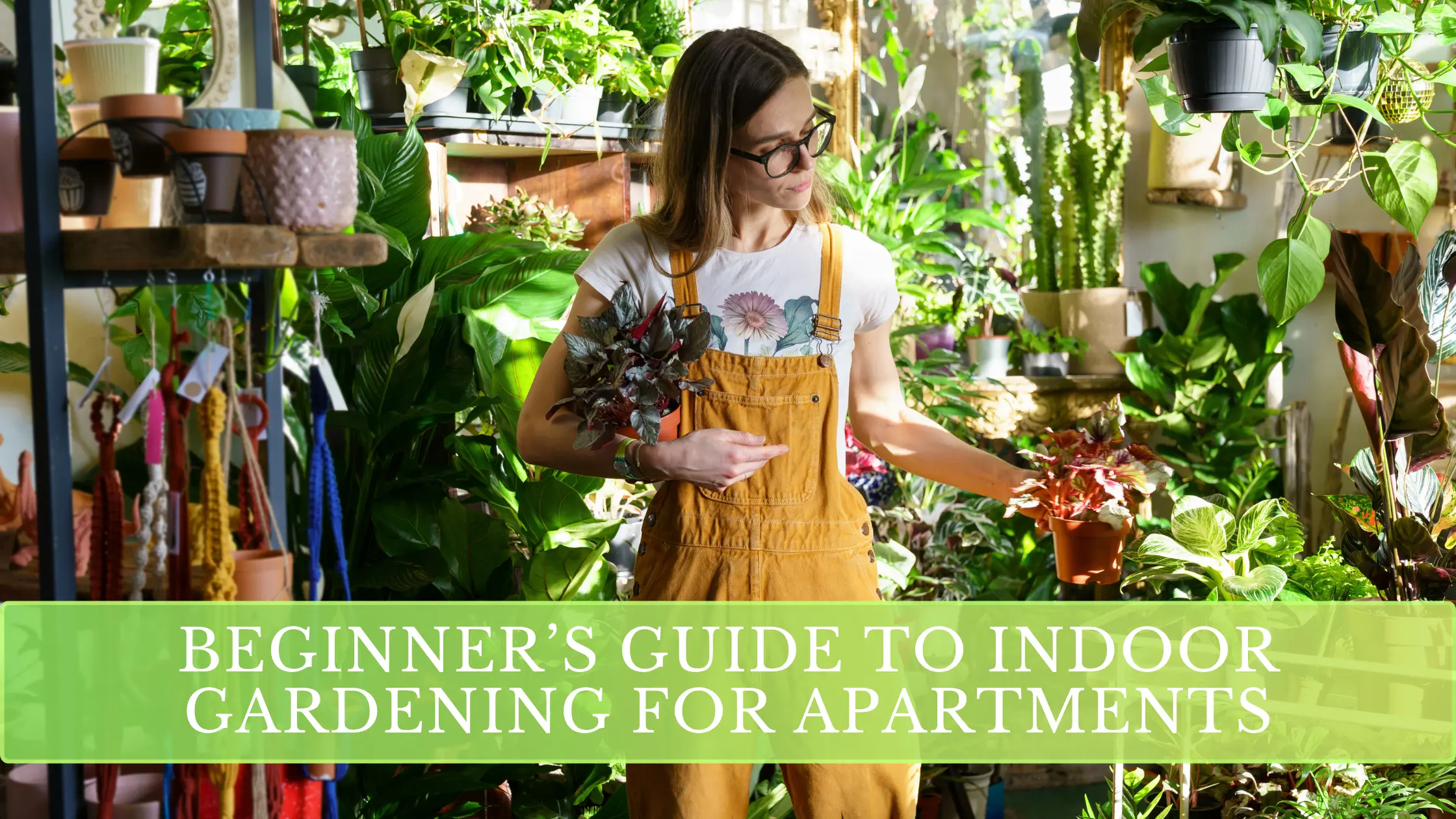Indoor gardening is more than just a pretty way to fill your windowsill—it’s your ticket to fresher air, a splash of green happiness, and the rewarding feeling of nurturing life in even the smallest city space. I started my own indoor gardening journey after moving into a high-rise with just one sunny window. Those first sprigs of basil and pothos brightened my mornings and made my studio feel like home.
Whether you’re a renter, a city dweller with limited outdoor space, or a total beginner dreaming of your first thriving houseplant, this guide is for you. We’ll walk step-by-step through everything you need for indoor gardening in apartments—so you can grow confidently, no green thumb required.
Table of Contents
Why Trust This Guide?
I’m a lifelong gardening enthusiast with more than a decade nurturing plants in apartments, from New York City to Toronto. After experimenting with nine different potting mixes, battling fungus gnats, and testing countless window setups, I’ve learned what works (and what flops!) for small-space gardeners.
For every step in this guide, I’ll reference reputable resources like university extension programs and Master Gardener recommendations. According to the University of Minnesota Extension, “the right plants in the right place make indoor gardening both enjoyable and successful.” Trusted advice, real results—so you can avoid rookie mistakes and enjoy more blooms.
Indoor Gardening Basics for Apartments
Before you pick a plant or pot, it’s essential to understand three core factors: light, space, and apartment limitations.
Understanding Light in Your Apartment
Most indoor plants need indirect or filtered sunlight. Here’s a quick, foolproof sunlight test:
- Bright/Direct: Place your hand in the light—if you see a sharp shadow, it’s direct sun.
- Medium/Indirect: A soft, blurry shadow signals medium light.
- Low Light: Minimal shadow means low light.
Check your window orientation:
- South-facing: Strongest, direct light (ideal for most food herbs).
- East-facing: Gentle morning sun (great for ferns and peace lilies).
- North/West-facing: Lower light, but plenty of options with the right plants.
Other Apartment Considerations
- Space: Use windowsills, shelves, or hanging baskets. Even a narrow ledge works!
- Pets/Kids: Many common houseplants can be toxic if ingested. The ASPCA (American Society for the Prevention of Cruelty to Animals) lists plant toxicity online—always check before buying.
- Roommates/Guests: Place plants where they’re safe from bumps, spills, and curious hands.
Essential Tools and Supplies for Apartment Gardening
You truly don’t need a jungle of gadgets to get started. Here are the basics:
| Tool | Why It’s Essential | Budget Tips |
|---|---|---|
| Watering can | Precise watering, less mess | Repurpose clean bottles |
| Small trowel/spoon | Digging, repotting | Soup spoon works in a pinch |
| Good potting mix | Healthy roots, fewer pests | Avoid “dirt” from outdoors |
| Drainage trays | Prevents root rot mess | Plates or takeout lids suffice |
| Pruning shears | Tidy, encourages new growth | Sharp kitchen scissors work |
For detailed product reviews, see my [Garden Tool Guide].
Trusted sources like Home Depot and your local garden center offer a range of starter kits—ask staff for pet-friendly options or budget packs.
Choosing the Right Plants—Success Starts Here
For apartment gardening, the best plants are resilient, low-maintenance, and easy on the eyes. Here are five proven favorites:
| Plant Name | Why It’s Great | Light Needs | Notes |
|---|---|---|---|
| Snake Plant | Super tough, air purifies | Low to bright | Low water, nearly indestructible |
| Pothos | Fast grower, easy trailing | Low to medium | Great for hanging baskets |
| ZZ Plant | Handles neglect | Low | Tolerates dry air, low light |
| Spider Plant | Air clean, pet-safe | Medium | Fun “babies” to propagate |
| Peace Lily | Elegant, blooms indoors | Medium to bright | Tells you when thirsty (wilting) |
Why these? Recommendations align with lists from the Toronto Botanical Garden and the University of Florida Extension—they’re known for forgiving care and purifying indoor air.
Where to Buy: Local nurseries often have healthier, acclimated plants, but for variety or bargains, check out big box stores or reputable online retailers (like The Sill, Plant Collective, or Home Depot).
Step-by-Step: Setting Up Your First Indoor Garden
Follow this easy checklist to get growing:
| Step | What To Do | Quick Tips |
|---|---|---|
| 1. Find Light | Do the sunlight hand test (see above) | Match plant to the brightest spot |
| 2. Pick a Pot | Use pots with drainage holes | Avoid pots without holes! |
| 3. Prep Mix | Use a high-quality indoor potting mix | Avoid “outdoor” soil—pests love it |
| 4. Plant | Gently remove from grow pot, loosen roots if circling | Don’t pack soil too tight |
| 5. Water | Give a good soak, then let drain | Water again when top 1in is dry |
Troubleshooting Tip Box:
- Droopy leaves? Check soil moisture—leaf wilting can mean over or under watering.
- Yellowing? Too much water, poor drainage.
- Pale or “stretchy” (“leggy”)? Move the plant closer to light, or try a grow light.
Maintenance Made Simple—Caring for Your Mini Garden
Watering: Check soil with your finger—if the top inch is dry, it’s time to water. Overwatering is the #1 beginner mistake!
Fertilizer: Less is more. Use a balanced, indoor plant fertilizer once a month during spring/summer. Always follow package directions.
Light: If leaves get pale or plants stretch toward the window, scoot them closer to natural light or supplement with a simple desk grow light.
Seasonal Care: Apartment temperatures are usually plant-friendly, but beware of winter drafts or radiators. According to Master Gardeners of North Texas, reduce watering in winter as most plants need less moisture.
Common Beginner Mistakes & How to Avoid Them
- Overwatering: Let the soil dry about an inch down before watering.
- Bad Soil: Use only indoor potting mix—never dirt from outside.
- No Drainage: Plants need pots with holes, or roots will rot.
- Wrong Light: Move plants to windows that match their light needs.
- Pests: Isolate new plants for a few weeks to spot bugs early.
Easy Fixes Table
| Mistake | Fix |
|---|---|
| Overwatering | Wait for dryness, use smaller sips |
| Bad Soil | Repot with fresh, sterile mix |
| No Drainage | Repot into container with holes |
| Low light | Try a low-light tolerant plant |
| Pests | Wipe leaves, use insecticidal soap |
Real Reader Stories/Testimonials
Are you a first-time plant parent? Share your wins or confessions down in the comments! Here’s a community favorite:
“I never thought I’d keep a plant alive until my pothos thrived on my kitchen shelf—even after forgetting to water it for a week!”
Your stories help other beginners feel right at home.
Quick Answers:
Q: What’s the best indoor plant for low light?
A: Snake plants and ZZ plants top the list.
Q: Can I use outside soil indoors?
A: No—stick to sterile indoor mixes to avoid pests and root disease.
Q: Are any houseplants pet-safe?
A: Spider plants and some ferns are generally safe, but always double-check with ASPCA listings.
Looking for more? See my [houseplant troubleshooting guide], [soil mix breakdown], and [window box buying tips].
Further Resources
- Recommended Books:
- “The New Plant Parent” by Darryl Cheng
- “Houseplants for a Healthy Home” by Jon VanZile
- Trusted Sites:
- University of Florida Extension
- Toronto Botanical Garden
- Canadian Houseplant Club on Facebook
Conclusion & Next Steps
Congratulations—your apartment is on its way to a thriving green home! What would you like help with next? Drop a question, share a photo of your unique plant shelf, or sign up for planty tips via my newsletter. Your journey inspires others—comment below with your best (or worst) beginner moment!

